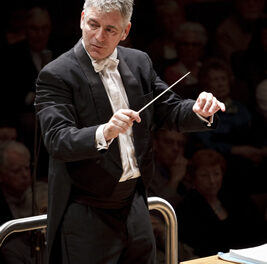JoAnn Falletta, Principal Guest Conductor, pianist Norman Krieger, and the Brevard Music Center Orchestra worked their collective magic to create a most memorable opening concert in Brevard Music Center’s Whittington-Pfohl Auditorium. Aside from the Beethoven Piano Concerto No. 4 in G, Op. 58 which dominated the first half, all other works on the program originated in operas from the nineteenth and early twentieth centuries with their associated plots and colorful characters. Sponsors for this 76th season are Jacquelyn and Bruce Rogow.
Falletta is a rather small woman with an elegant and quiet demeanor whose motions on the podium are of such economy they effectively direct without attracting undue attention to her. Her emotional investment in the music and personal warmth were obvious to the observer — no matter that her back is turned to the audience — and she is a master of stylistic differentials on many levels. She is eager to bring unfamiliar music to audiences — and such was the case with Austrian composer Franz Schmidt’s Intermezzo from his opera Notre Dame which opened the second half. Krieger is a distinguished Professor of Keyboard Studies at the Thornton School of Music, University of Southern California. Additionally, he performs as a soloist with major orchestras in the US and abroad and is also active as a chamber musician and solo recitalist. Both he and Falletta are Julliard School graduates.
The program opened with Berlioz’s “Roman Carnival” Overture, Op. 9, a work which was first performed in Paris in 1844, shortly after the publication of the composer’s seminal treatise on orchestration. The overture’s two main themes are derived from the chorus “Come Ye All, People of Rome” and the carnival scene “Ah, Sound the Trumpets, Sound the Bagpipes, Sound the Gay Tambourines” from his own opera Benvenuto Cellini. The opening orchestral bustle transitions quickly to an extensive and gorgeous English horn solo before being taken over by the violas. Berlioz’s idea of a carnival is first and foremost an Italianate, lyric extravaganza which only later gives way to the allegro bustle one might naturally associate with a carnival. The orchestra delivered a thrilling performance of this colorful work, with copious nods to both English horn and brass.
With the undeniable lyrical quality of the opening movement of Beethoven’s Piano Concerto No. 4, one could be lulled into thinking the technical demands of the piece have been subordinated to other compositional aims, but in the end, no, it’s still very much a concerto. I have remarked in another review about the orchestral challenges playing Beethoven presents, not the least of which is the intense concentration required from the conductor and every player to focus over lengthy periods of time to maintain the energies the composer sets in motion. This was perhaps the most satisfying aspect of this performance — that ability to sense and sustain the appropriate tempo and mood over time. In addition to his formidable technical chops, Krieger plays with a gorgeous palette of colors which made the most transparent and slow-moving passages of this concerto simply and utterly breathtaking. His use of Beethoven’s cadenzas for movements one and three illuminated on another level the composer’s prodigious imagination, as one idea segued into another with Beethoven’s inimitable logic.
The program’s second half consisted of two works of the twentieth century. Franz Schmidt was an early 20th‐century Austrian who played in Gustav Mahler’s orchestra at the Vienna State Opera. His Intermezzo is from his 1914 verismo opera Notre Dame, an adaptation of Victor Hugo’s novel. One of three extant orchestral excepts, the Intermezzo which occurs near the end of the opera’s Act I is a portrait of the tragic figure of the Gypsy girl Esmeralda, one of the most sympathetic characters in the story. To paint a musical portrait à la Hongroise, Schmidt loads, even overloads, the strings with impassioned melody which is unrelentingly intense throughout this short work.
This was followed by the enormously popular Suite from Der Rosenkavalier, Op. 59 by Richard Strauss, whose opera (to quote from Bruce Murray) “inhabits simultaneously the Vienna of Mozart, the Vienna of Johann Strauss II, and presumably, the Vienna of the early twentieth century, thereabouts.” The enormous breadth of this referential frame was ingeniously captured in this orchestral suite (largely the result of the efforts of Strauss’s publisher) which includes music from the prelude illustrative of the night of passion between the Marschallin and her young lover Octavian, Octavian’s role as the Rosenkavalier, the bearer of the silver rose, a duet between Octavian and his new young love Sophie, a series of waltzes, nostalgic music of the Marschallin as she recalls her former young lover Octavian, and the boisterous and heady concluding music. The orchestration is a real kitchen-sinker, of such depth and heft one has the impression that all the best hands were called on deck to play this one. Falletta led the orchestra in an electrifying performance, capturing perfectly the heady and reckless quality that must have been essential to fin de siècle Vienna.












